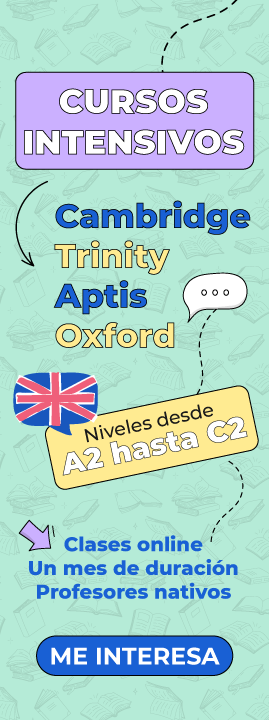Connectors in English

What are connectors?
ÍNDICE DE CONTENIDOS
- Copulative connectors in English
- Disjunctive connectors in English
- Conditional connectors in English
- Concessive connectors in English
- Conclusive connectors in English
- Continuous connectors in English
- Adversative connectors in English
- Causal connectors in Spanish
- Comparative connectors in English
- Functional connectors in English
- Sequencer connectors
Connectors are words or groups of words whose main function is to establish some kind of relationship between the sentences that are part of a text. Depending on the type of connector we use, we will give a certain meaning to our text. That is, if we change the connector, we will give it a totally different meaning.
Because they are important
It is an essential tool to be able to express yourself properly and fluently in your second language.
First, they help structure a written or spoken speech . This is vital for your readers or listeners. A text works as a kind of map, where the reader must know, at all times, where he is with respect to the global whole. Connectors can help you deliver that all-important structure.
On the other hand, they also work very well to give richness and fluidity to your writing or speeches . It is not the same to use simple, short, disconnected phrases, than to link them all in one using a connector.
Copulative connectors in English
The copulative connectors in English have the function of joining two events. These events do not have to always be at the same grammatical level, but one must be subordinate to another. In addition to adding ideas to those already mentioned in the previous sentence, copulative connectors can also serve to oppose them, as well as balance them at the level of importance.
- And: y
- Not only… but also: no solo…y también
- Not only… but… as well: no solo…y…también..
- Both… and: ambos…y
- No sooner … than: apenas…cuando
Disjunctive connectors in English
Unlike copulative connectors, disjunctive connectors in English serve to give one or more alternatives to the idea proposed by the previous sentence. As in the case of most connectors in English, disjunctive connectors also have their employees for negation. In some cases they also express circumstance, that is, they mention the fact that it may occur if another event is not fulfilled.
- Or: o
- Either… or: o… o
- Neither … nor: no … ni
- Wether … or: si … o
- Or else: or sino
- Otherwise: deotro modo
Conditional connectors in English
As the name implies, conditional connectors in English are used to express a condition. They are used to join two ideas in such a way that one depends on the satisfactory result or not of the other. They can express specific cases or more general truths. Conditional connectors are used mostly in the four English conditionals.
- If / whether: si
- Unless: amenos que
- Provided / providing / as long as: siempre que, mientras
- In case: en caso de que
Concessive connectors in English
The concessive connectors English serve to express an objection to the main idea of the sentence. Normally this objection is presented as a negative event to the positive event expressed by the main sentence. It is important to pay attention to the use of each of the forms expressed here, because although they seem to mean the same thing, each concessive connector is used under specific conditions.
- Although / though / even though: aunque
- Even if: incluso si…
- Not even if: ni siquiera si
- Despite / in spite of: a pesar de
- Regardless of: sin importar
Conclusive connectors in English
The conclusive connectors English are used to conclude and / or circumstance to the proposed event in the main clause. Unlike what happened with the concessive connectors, in the conclusive connectors the biggest problem that we can find is in the formality of each of the connectors. We must pay special attention to the registry used at all times in order to adapt to the situation.
- Therefore: por lo tanto
- Hence: de ahí
- Thus: por lo tanto
- So: entonces
- Consequently: por lo tanto, en consecuencia
Continuous connectors in English
The c onectores English consecutives used to add an event related to the principal. It is also said that continuous connectors in English serve to give continuity to the main sentence, that is, to fill in the temporal gap after an event explained above.
- Then: entonces
- Moreover / furthermore / besides:además/ por otra parte/ para colmo
- In addition to: además
- Not only… but also: no solo…sino que también/incluso
- What´s more: lo que es más
- Parallel that: paralelamente, junto a eso
Adversative connectors in English
The adversative English connectors serve to oppose a difficulty to the situation presented above. These adversative connectors in English may present a specific inconvenience or a different alternative to the initial one. As with the conclusive connectors, greater attention must also be paid to the register used, as some turn out to be strongly more formal than others.
- But: pero
- However: sin embargo
- Nonetheless / nevertheless: sin embargo
- Yet / even so: y asi, sin embargo
- Still: sin embargo
- Instead: en su lugar
- Whereas / while: mientras tanto
- On the contrary: al contario
- On the other hand: por otro lado
- In other matters: por otro lado
- Nor: ni
- Notwithstanding: a pesar de que
Causal connectors in Spanish
The causal connectors English are used to give a reason for a fact. In the vast majority of cases the main sentence explains an event caused by the result of the secondary sentence. As with many types of connectors, causal connectors are also used according to the speaker’s speech register, so care must be taken not to be too formal or too vulgar.
- Because: porque
- Because of: debido a
- For: para
- Since: desde
- As: puesto que
- Due to / owing to: debido a
- In order to: para / con tal de
- By means of: por medio de
- For lack of: por falta de
Comparative connectors in English
The comparative connectors English serve, as its name suggests, express a degree of equality or difference between two sentences. Many of these comparative connectors are not based only on one word, but are formed by two words separated by an adverb or adjective that establish the quality of differentiation of both sentences.
- As: como
- As … as: tan … como
- Not as / so… as: no tan… como
- As if: / as though: como si
- Than: que
Functional connectors in English
The functional English connectors serve to express the cause or purpose of a sentence. The main sentence expresses a situation normally carried out for the second sentence to be possible. Functional connectors are possibly the most difficult types of connectors in English to learn, although they are not much of a problem at all.
- So: entonces
- So that: what para que
- So as to: para que/ de que manera
- So as not to: para no
- In order to: para
Sequencer connectors
- First / firstly: primero /en primer lugar
- Second / secondly: segundo / en segundo lugar
- Next / then: seguidamente / luego
- After / afterwards: despues / más tarde de
- Finally / eventually: finalmente / al final
- Last but not least: por último, si bien no menos
- At the same time: al mismo tiempo
- Joined: added to
- Likewise: igualmete, al igual
- Nowadays: hoy en día
- Currently/at present/at the present time/now/these days: actualmente
- A long time ago: hace mucho tiempo
- In ancient times: en la antigüedad
- Not long ago: hace poco tiempo
- In former times: en tiempos pasados
- Formerly: antiguamente
- In the old days: en los viejos tiempos
To give examples
- For example: por ejemplo
- For instance: por ejemplo
- Such as: tal como
- Like: como
- Apart from: aparte de
To generalize
- Mostly: prácticamente/ normalmente/ mayoritariamente
- In general: en general
To clarify
- That is to say: es decir
- In other words: en otras palabras
- i.e. (id est): es decir
To emphasize
- as a matter of fact: por cierto/de hecho
- definetely: en efecto/definitivamente
- obviously: obviamente
- above all: sobre todo
- actually: de hecho
- indeed: es más
- in fact: de hecho
In conclusion
- In conclusion: en conclusion
- To sum up: para resumir
- In short: en resumen
- All in all: en suma, en definitive, después de todo
- In brief: en resumen
- On the whole: en general
Positives and negatives
- Fortunately: afortunadamente
- Happily: afortunadamente/por fortuna
- Unfortunately: desafortunadamente/desgraciadamente
- Sadly: desafortunadamente/desgraciadamente/tristemente
To declare certainties
- Obviously: obviamente/evidentemente
- Undoubtedly: indudablemente
- Surely: seguramente
- Indeed: verdaderamente/en realidad/en efecto
- Apparently: claramente/aparentemente/al parecer
- Possibly: posiblemente
To finish, below we leave you a series of links ordered by level:
General list of connectors in English
Lista general de conectores en inglés
Lista de conectores en inglés nivel A2
Lista de conectores en inglés nivel B1
Lista de conectores en inglés nivel B2
Lista de conectores en inglés nivel C1
Lista de conectores en inglés nivel C2
We hope they are of great use to you, and don’t forget to share the post!
In addition, and if your search for connectors is motivated because you want to obtain your official title, here we remind you of the closest calls.




alternatives